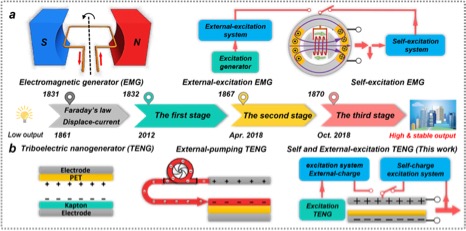On March 29, 2019, a research paper titled “Integrated charge excitation triboelectric nanogenerator”, finished by the research team led by Professor Hu Chenguo from the School of Physics of Chongqing University in collaboration with the team of Academician Wang Zhonglin from the Beijing Institute of Nanoenergy and Nanosystems, Chinese Academy of Sciences, was published in Nature Communications, a sub-journal of Nature. Chongqing University is the first organization and the corresponding organization. Dr. Liu Wenlin of Chongqing University is the first author. Professor Hu Chenguo of CQU, Academician Wang Zhonglin from Beijing Institute of Nanoenergy and Nanosystems and Post-doctor Guo Hengyu from Georgia Institute of Technology are corresponding co-authors.
With rapid development of portable devices, wearable devices and the Internet of Things, people are making enormous efforts to develop sustainable, portable and decentralized energy. At the same time, the environmental mechanical energy related to human activities provides ideal energy source for energy collection. Compared with the traditional electromagnetic generators, the Triboelectric Nanogenerator (TEGN) has lower weight, lower cost and higher efficiency of low-frequency energy collection, and it has therefore drawing extensive attention in the past few years. As the energy output of TENG is in direct proportion to the square of its density of surface charge, the low density of surface charge on the surface of friction materials poses serious constraints on the practical application of TENG. In order to increase the density of surface charge of TENG, people are trying to improve the density of surface charge by improving the friction materials. However, little improvement has been seen. For this reason, the external charge pumping has been proposed to increase density of surface charge, which has resulted in a high density of surface charge of 1mC/m2. However, the practical application of external charge pumping TENG is limited by its low charge injection rate and complicated structure.
The external charge excited TENG and self-charge excited TEGN developed based on the voltage doubling circuit, which are similar to the traditional excitation generator, are described in the paper. The structural design allows the exciting charge to be directly stored in the electrode, and a high density of surface charge of 1.25mC/m2 has been obtained. In addition, compared with the external charge pumping, self-charge exciting brings about increase of charge injection rate of 10 times. With the pumping TENG part removed, a simpler TENG structure has been obtained. This shows the great potential value of self-charge excited TEGN in expanding the practical application of TEGN. Considering the development history of the electromagnetic generators, the development of self-charge excited TEGN also makes large-size and high-voltage generation application of TEGN possible.
This research has been supported by the National Natural Science Foundation and the operation expense for basic research in colleges and universities allocated by the central government.

Link of the paper: https://www.nature.com/articles/s41467-019-09464-8

